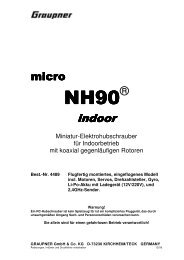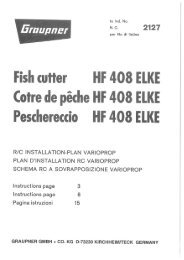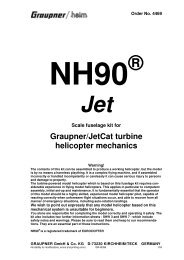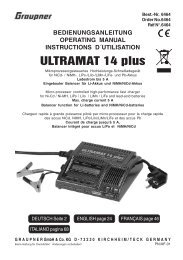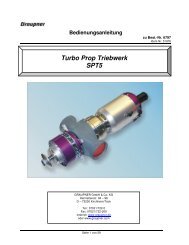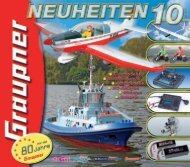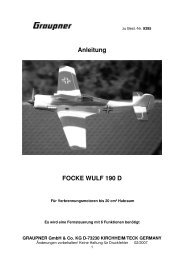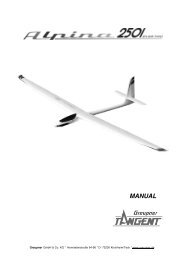Anleitung EXTRA 300 SHP - Green Hobby & Model
Anleitung EXTRA 300 SHP - Green Hobby & Model
Anleitung EXTRA 300 SHP - Green Hobby & Model
Sie wollen auch ein ePaper? Erhöhen Sie die Reichweite Ihrer Titel.
YUMPU macht aus Druck-PDFs automatisch weboptimierte ePaper, die Google liebt.
The tailwheel unit can now be attached to the tail end of the fuselage, so that the<br />
model can be stood upright prior to fitting the cowl.<br />
Fix the tailwheel unit to the underside of the fuselage: note that the hinge axis of the<br />
rudder should line up with the pivot axis of the tailwheel unit.<br />
Cut off the tailwheel leg flush with the end of the plastic driver, as shown in the photo.<br />
Mark the position of the retaining screws on the underside of the fuselage, drill pilotholes<br />
at the marked points, and install the unit permanently. Fit a screw through the<br />
tailwheel driver and into the underside of the rudder, positioned about 5 mm short of<br />
the end of the guide slot.<br />
Assembling and installing the fueltank<br />
Cut a piece of silicone fuel tubing and push it onto the fueltank clunk weight. Push<br />
the free end of the fuel tubing onto one of the tubes in the fueltank stopper, and<br />
check that the clunk will be able to move freely inside the tank without binding or<br />
jamming when the stopper is in place. Use a heat-gun or a match to heat the<br />
projecting plastic tubes slightly; this will soften them, so that they can be curved to<br />
the shape shown in the illustration. Check that one pipe points down (filler line) and<br />
one up (vent line; this is the overflow when you are filling the tank). Extend these two<br />
tubes with silicone fuel tubing so that they reach the top and bottom of the tank. Push<br />
the stopper into the tank and tighten the cross-point clamping screw. Ensure that the<br />
screw is tight enough to seal the fueltank completely. You can check this by holding<br />
the tank under water: blow into the tubes and watch carefully: if bubbles rise, there is<br />
a leak which must be sealed.<br />
Cut three pieces of silicone fuel tubing and push them onto the tubes where they exit<br />
the fueltank.<br />
Mark the fuel lines using a felt-tip pen or coloured tape to indicate which is the fuel<br />
feed, the overflow and the filler.<br />
Fit the tank in the fuselage through the main opening, and thread the fuel tubes<br />
through the hole in the nose bulkhead.<br />
Connect the fuel feed tube (the one connected to the clunk pick-up inside the tank) to<br />
the carburettor nipple, and route the overflow pipe down. At a later stage the<br />
refueling line can be run to the outside through a hole in the cowl.<br />
The next step is to install the cowl: the retaining screw holes must first be marked on<br />
the fuselage. Apply pieces of paper masking tape to the fuselage, and mark the<br />
position of these holes on the tape; they should be about 20 mm aft of the nose<br />
bulkhead, to coincide with the reinforcements glued on the inside of the fuselage.<br />
Now measure a point 100 mm aft of each hole position. Place the cowl on the<br />
fuselage and mark the position of the screw holes on the cowl by measuring 100 mm<br />
forward of the rear marked points.<br />
When fitting the cowl, please note that the fairing for the spinner should line up<br />
GRAUPNER GmbH & Co. KG D-73230 KIRCHHEIM/TECK GERMANY<br />
Änderungen vorbehalten! Keine Haftung für Druckfehler 02/2007<br />
33



